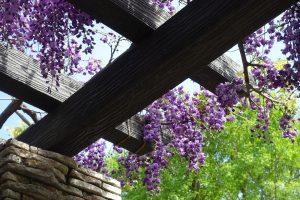Last Updated on January 11, 2022 by Real Men Sow
Wisteria is a climbing deciduous shrub. A mature wisteria will transform your property with its beautiful pendants of fragrant flowers in May and June. It is a strong, woody plant with strong stems. In time, the trunks can grow as tall as small tree trunks. This gorgeous flower can also grow in pots and outdoors, depending on what you’d like to do.

You should ensure that you only buy a wisteria plant that has been grafted. If you buy a plant from seed, you can expect to wait up to 20 years before it flowers. Grafted plants are easily identified by a bulge at their base. Grafted plants can take as long as five years to bloom. Grafted wisterias are not available for sale in most nurseries.
How to Grow Wisteria Plant
Plant wisteria against a strong wall of moist, well-drained soil. It would grow well in a south-facing garden. Prune them in February, and again in August. To encourage flowers, fertilize with high-potash fertilisers in spring.
Where to Plant Wisteria
Wisteria is a sturdy plant that can live for many years. A solid wall with galvanized wires supporting the plant is ideal. Wisteria plants can be difficult to move once they are established, therefore, it’s best to make sure that you have the right space and support. If your pergola isn’t very strong, don’t attempt to grow wisteria there. They will bend and tear weak structures. All wisteria cultivars need to be in full sun or semi-shade. Ideal soil conditions are moist and well-drained.
Steps to Plant Wisteria in Pots and Outside
Spring and autumn are the best times to plant wisteria. Improve the soil before planting by adding well-rotted organic material such as garden compost and well-rotted manure. To train the plant, you can plant wisteria against walls and then run galvanized wires along with it. Water well and plant at the same height as the original pot. Although wisterias can grow in containers, they are not as productive as plants grown in the garden. If you are training the plant to be a standard tree, it is best to plant wisteria only in a container. Use the largest container possible and good shrub and tree compost. Give it a good watering and then feed it in the spring.
Taking Care of Wisteria in Pots
Feed your Wisteria with high-potash to encourage flowers to grow. Make sure to prune them too.
Pruning Wisteria Plants
Prune wisteria in August and February. Not pruning them would only make them grow bigger but wouldn’t flower well. In the first few years, you should focus on training the plant to use the support. You will need to prune very low branches, train strong side shoots, and cut back the side shoots to five buds by early August. Cut back any shoots below the graft union to prolong the life of the Wisteria. Pruning wisteria in August involves reducing the growth of mature plants to five leaves. This is a time when the long, wispy growth can be very noticeable and should be removed immediately. The same shoots should be cut when pruning wisteria in February. However, the buds should only be reduced to three. Don’t worry about dying mature plants.
Propagating Wisteria in Pots
Because the wait for wisteria flowers can be too long, only a few gardeners propagate it. If you are looking for a challenge, however, cut softwood cuttings mid-spring. Cut lengths of the new stem to approximately 15cm. Then remove the parent plant from above a leaf joint. Reduce the material to 10cm just below the leaf joint. The lower leaves should be removed, and four more should remain at the top of each cut. After filling pots with compost, level it and then firm it. Finally, water the pots. Place the cuttings in the pots, making sure they don’t touch the leaves then cover the pots with a clear plastic bag. Place the cuttings in a brightly lit area and make sure they don’t dry. Remove the bag when signs of growth appear then plant in a pot.


